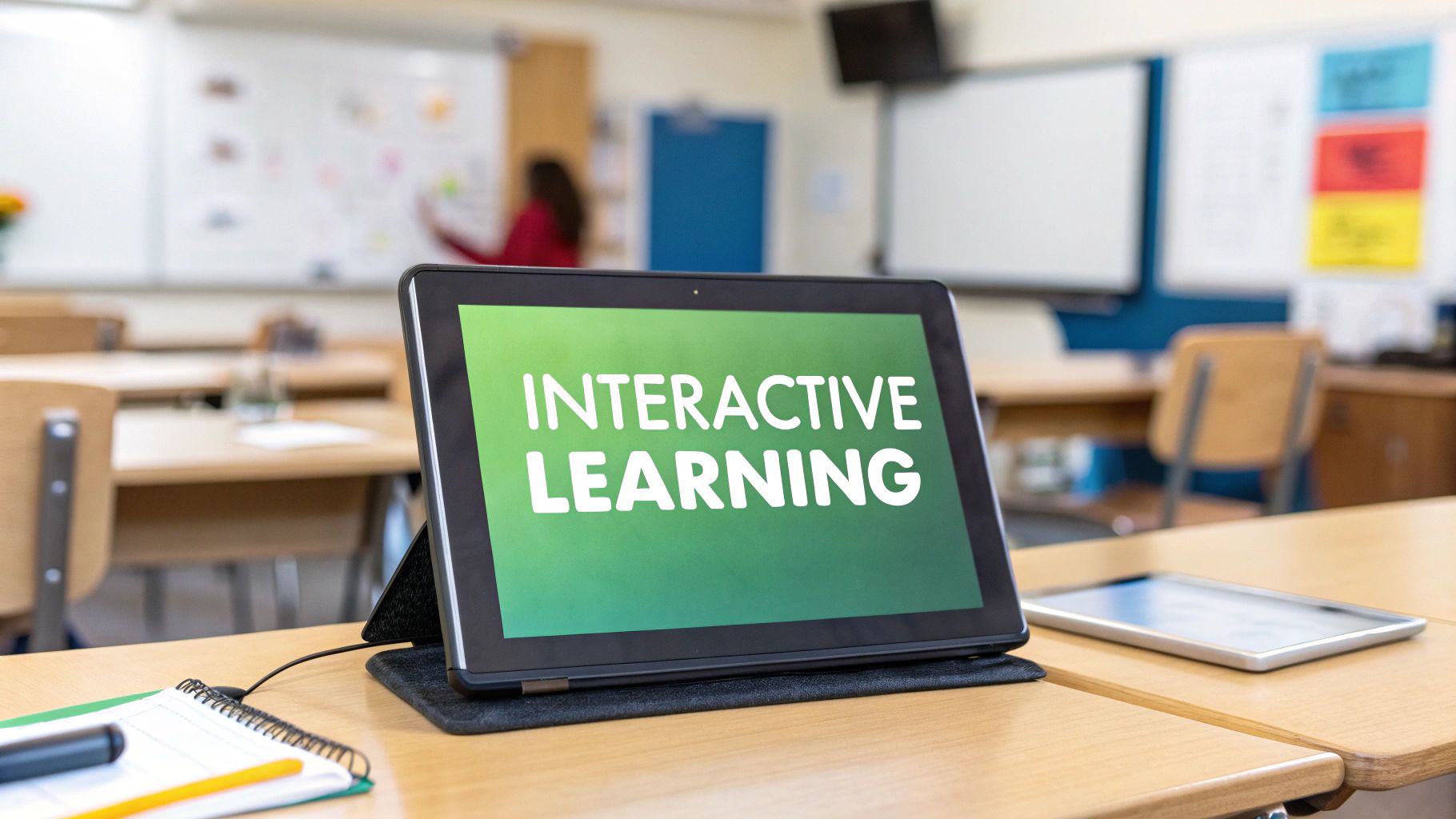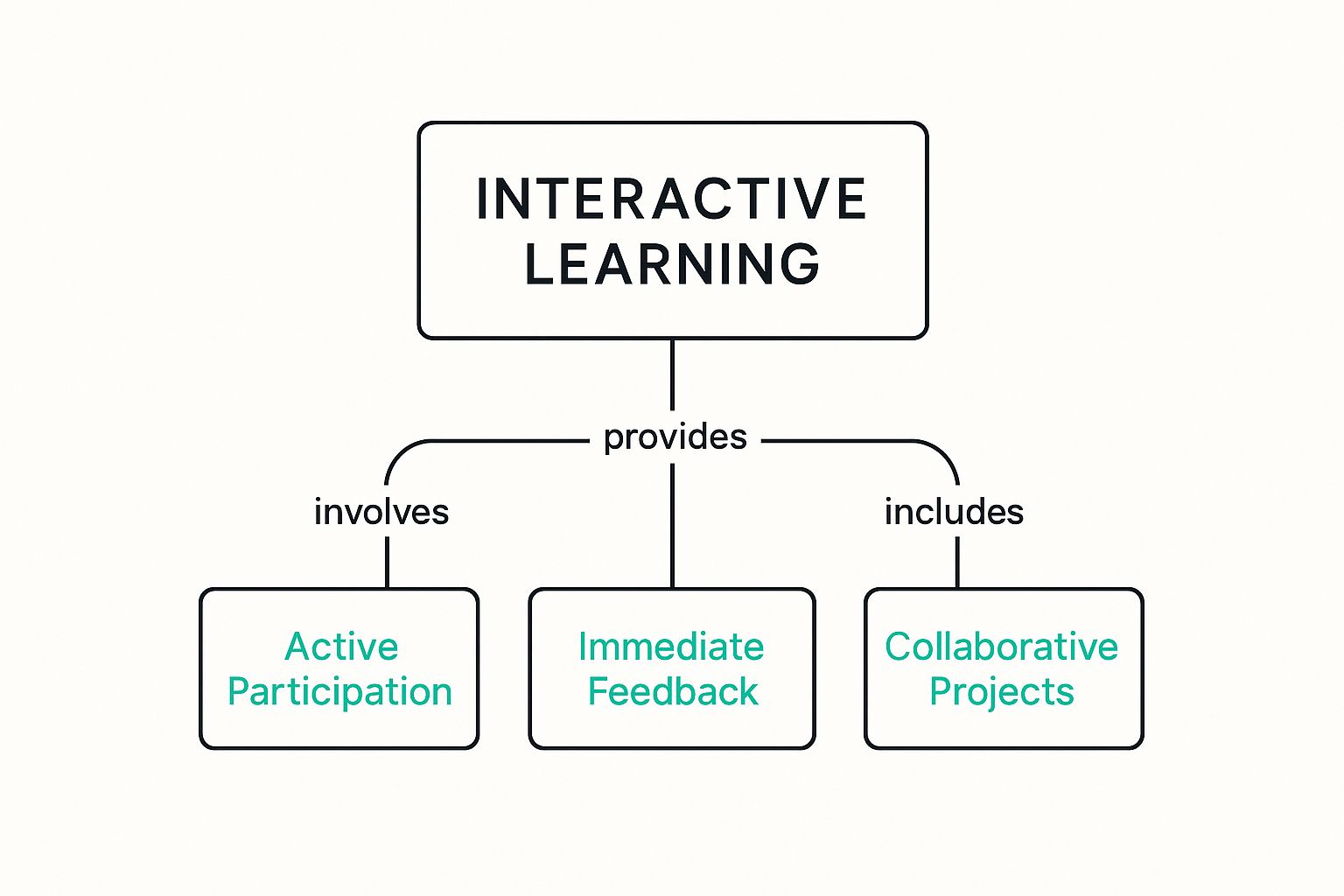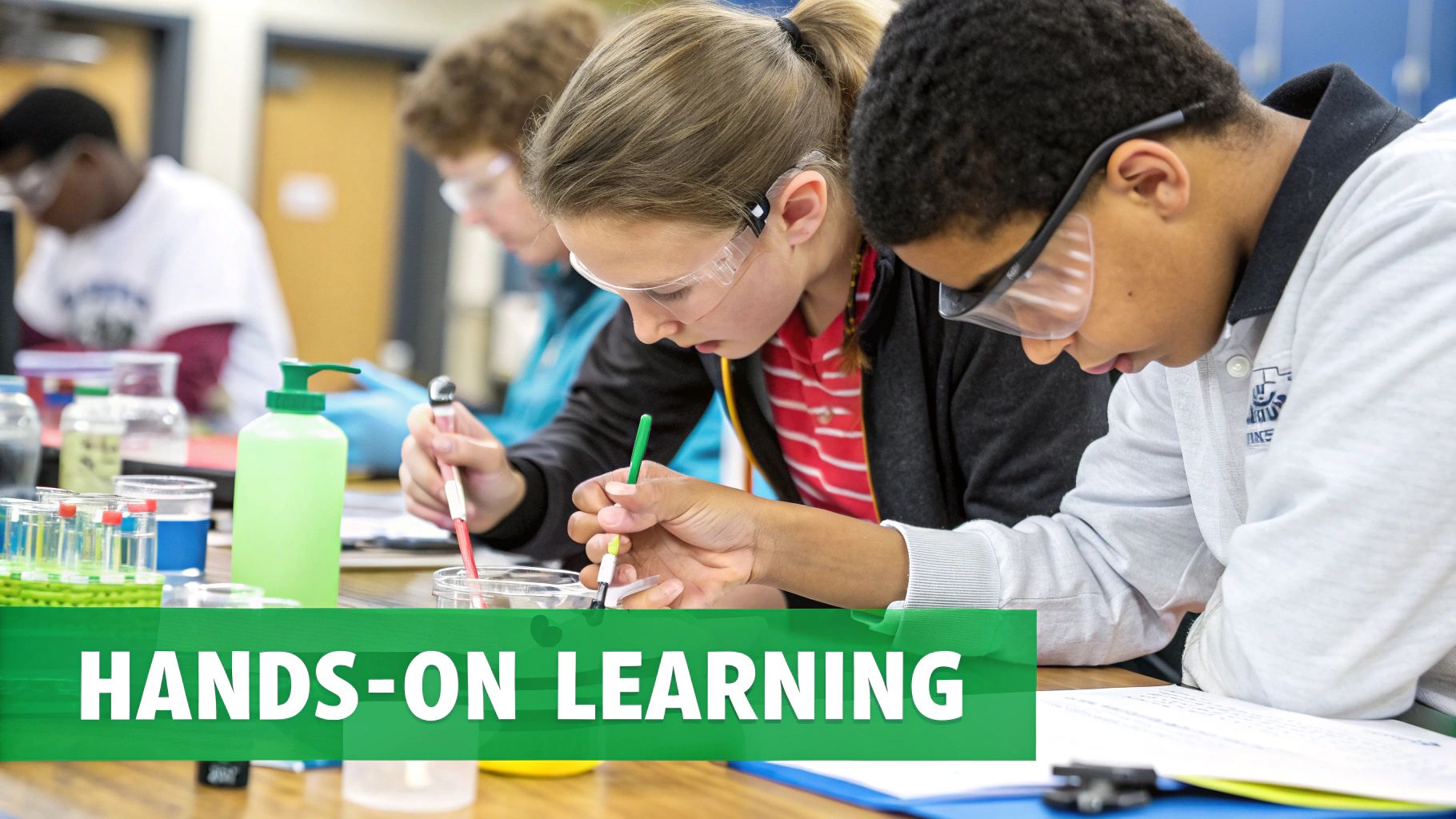What is Interactive Learning? Unlock Engaging Education Now
Discover what is interactive learning, its benefits, and how it transforms education. Learn how interactive tools enhance student engagement today.

Interactive learning isn't just a buzzword; it's a completely different way of thinking about education. It's the shift from being a passive spectator to an active participant. Instead of just listening to a lecture or reading a textbook, you're thrown into the driver's seat—learning by doing, collaborating, and solving real-world problems.
Unpacking the Shift From Passive to Active Learning
Think about it this way: you can't learn to swim by reading a manual. You might understand the theory of buoyancy and stroke technique, but you’ll never really know how to stay afloat until you jump into the water.
That’s the core difference between old-school passive learning and today’s interactive approach. It’s a fundamental move away from one-way information dumps and toward a two-way conversation between you and the material.
This dynamic method pulls students in through discussions, problem-solving, and hands-on activities. It’s exploded in popularity alongside digital tools that make these experiences easier than ever to create and access. The market reflects this massive shift—global e-learning is expected to rocket past $350 billion by 2025 and could even hit an eye-watering $2.28 trillion by 2035. You can dig deeper into the growth of the e-learning market on zealousys.com.
This simple concept map breaks down how it all works. The pillars are active participation, consistent feedback, and collaboration.

As you can see, these elements don't work in isolation. They weave together to create a powerful learning experience that goes far beyond just memorizing facts for a test.
Passive Learning vs Interactive Learning at a Glance
To really nail down the difference, it helps to see the two approaches side-by-side. The contrast is pretty stark.
| Aspect | Passive Learning | Interactive Learning |
|---|---|---|
| Learner Role | Recipient of information | Active participant and co-creator |
| Primary Activity | Listening, reading, memorizing | Doing, discussing, problem-solving |
| Communication | One-way (instructor to learner) | Two-way and multi-directional |
| Focus | Information transmission | Skill development, critical thinking |
Ultimately, the table shows that passive learning is about knowing something, while interactive learning is about understanding and applying it. That's how you build a deeper, more permanent connection to what you're trying to master.
The Real Benefits of Active Engagement

Let's move past the theory. The real power of interactive learning is rooted in how our brains are wired. When you’re actively involved, you aren't just memorizing facts for a test; you're forging new neural pathways that make information stick.
This is why students in active learning environments consistently outperform those in traditional lectures. Instead of passively receiving information, you’re pushed to question, analyze, and apply it. It’s the difference between watching a cooking show and actually making the meal yourself—only one of those truly teaches you how to cook.
By actively engaging with material, learners construct their own understanding. This personal connection to the content is the key to deep, lasting knowledge retention and the ability to apply concepts in new situations.
The payoff goes far beyond just acing an exam. This hands-on approach builds essential skills that are invaluable in any career.
Sharpening Critical Thinking and Soft Skills
Interactive methods, by their very nature, force you to think on your feet. When you're dropped into a problem-based scenario, you have to evaluate information, weigh different solutions, and defend your choices. That’s critical thinking in action.
And because so many of these activities are collaborative, you're constantly honing the soft skills that employers crave. You get real-world practice in:
- Communication: Getting your ideas across clearly to teammates and instructors.
- Teamwork: Working together toward a shared goal, learning to compromise, and building on each other's strengths.
- Problem-Solving: Tackling challenges as a group and brainstorming creative, effective solutions.
Think about it this way: trying to learn geography by just staring at an atlas is a passive, forgettable experience. But when you actively explore a 3D world, hunt for landmarks, and compete in challenges, you engage your brain on multiple levels. To see how this works in practice, check out our guide on how to learn world geography. That shift from seeing to doing is what turns learning into an experience you actually remember.
Proven Interactive Learning Methods

So, how do you actually put interactive learning into practice? It all comes down to picking the right strategy for the right goal. A few methods have proven time and again to be incredibly effective at turning passive listeners into active, engaged problem-solvers.
These approaches are way more than just tacking a quiz onto the end of a lecture. They fundamentally flip the script on how learning happens.
One of the most powerful strategies is Problem-Based Learning (PBL). The whole process kicks off with a complex, real-world problem. Learners then huddle up in groups to dissect the issue, figure out what they don't know, and go hunt for the solutions.
Instead of being spoon-fed facts, they have to pull information as they need it. This creates a much stronger, context-rich understanding. Imagine a marketing class tasked with launching a new product on a shoestring budget—they're forced to learn about market research, ad platforms, and analytics on the fly, because they need it to solve the problem.
Sparking Curiosity and Collaboration
Another fantastic approach is Inquiry-Based Learning. This method puts the learner squarely in the driver's seat. It empowers them to ask their own questions and investigate topics that genuinely spark their interest.
This flips the traditional model on its head. The student’s own curiosity becomes the compass for their educational journey, making the whole thing feel personal and way more engaging.
Collaboration is a common thread woven through all these methods. When students work together, they don’t just learn the material; they learn from each other's unique perspectives, sharpen their communication skills, and figure out how to be part of a team. This peer-to-peer dynamic often unlocks insights that are impossible to find when studying alone.
You can see this in action when players team up or compete in a 3D geography game, turning what could be a solitary task into a fun, shared adventure.
The core idea behind all these methods is simple but profound: learning is not a spectator sport. When we create an environment where learners have to actively grapple with challenges, we build more than just knowledge. We build real competence and confidence.
These strategies are what move education beyond rote memorization and into the world of practical, hands-on application—which, at the end of the day, is the whole point of learning anything meaningful.
Here's the rewritten section, designed to match the human-written, expert style of the provided examples.
How Technology Is Fueling Interactive Learning
Technology is no longer just a digital textbook—it's the engine powering a massive shift in how we learn. It acts as a powerful amplifier, turning abstract concepts into tangible, hands-on experiences and building educational worlds that were once the stuff of science fiction.
At the heart of this change is artificial intelligence (AI). Forget one-size-fits-all lessons. AI creates truly personalized learning journeys by figuring out a student's weak points in real-time and serving up targeted exercises. It can also spot when a learner is ready for a bigger challenge and adapt accordingly, ensuring everyone gets the right level of support.
Creating Immersive Educational Worlds
This is where things get really exciting. Immersive tools like Virtual Reality (VR) and Augmented Reality (AR) are literally breaking down the classroom walls. Imagine a history student not just reading about ancient Rome, but actually walking its streets with a VR headset. Or think of a trainee mechanic using an AR app to see a jet engine's parts overlaid on the real thing, watching how they all fit together.
These tools make learning incredibly hands-on and, most importantly, memorable. This isn't just a niche trend; it's a mainstream movement.
By 2025, an estimated 60% of educators are expected to use AI tools daily. The global AI in education market hit $7.57 billion in 2025, and projections show it could explode to $112.30 billion by 2034. You can learn more about the rise of technology in education on digitallearninginstitute.com.
Gamification is the other key piece of the puzzle. It uses game mechanics—like points, badges, and leaderboards—to supercharge motivation. This simple trick transforms learning from a chore into a fun, competitive challenge, getting students genuinely excited to participate and progress.
When you combine these digital tools, the answer to "what is interactive learning?" becomes bigger and more dynamic every day. Technology is making it more accessible, scalable, and deeply engaging for everyone.
Interactive Learning in the Real World

It’s one thing to talk about interactive learning in theory, but where does it actually show up? The truth is, it’s all around us. These methods are being used every single day in schools, offices, and universities to make learning stick.
Think about a high school history class. Instead of a teacher just reading review notes before a test, they launch a gamified quiz. Suddenly, the entire room is buzzing. Students are on their phones, competing to lock in answers first. That simple shift turns a passive review session into a memorable, high-energy game.
This same idea—getting people actively involved—works just as well for complex professional skills.
From Corporate Training to University Labs
In the business world, a sales team might jump into a simulation to practice navigating a tricky negotiation. It's a risk-free sandbox where they can experiment with different tactics, get immediate feedback on what works, and build real confidence before they ever face a client. They learn by doing, not just by listening.
The real power of interactive learning is its flexibility. It can adapt to any subject or skill, from a simple classroom quiz to a complex corporate simulation, because it always puts active participation ahead of passive listening.
You’ll find it in university labs, too. Engineering students can use collaborative digital whiteboards for a group project. Even if they’re in different cities, they can all sketch designs, mark up schematics, and solve problems together in real-time, which is exactly how modern engineering teams operate.
These examples prove interactive learning isn't about one specific tool—it's a mindset. It can be as straightforward as a competitive quiz or as immersive as a geo-exploration game. For a great example, check out our GeoGuessr vs EarthChasers comparison to see how different platforms get you to actively discover the world.
Answering Your Top Questions About Interactive Learning
As the world of learning shifts from passive lectures to active participation, a lot of questions pop up. It's totally normal. Moving away from methods we've known our whole lives can feel like a leap, but once you get the practical side of interactive learning, it all starts to click. Let's tackle some of the most common worries.
One of the biggest myths is that interactive learning is just for kids. Sure, games and hands-on activities are brilliant for younger learners, but the core ideas—engagement, problem-solving, and teamwork—are powerful at any age. Corporate training programs use intricate simulations to hone negotiation skills, and university students team up on real-world engineering challenges. Both are perfect examples of interactive learning built for adults.
Is This Going to Be Expensive?
Another hang-up is the cost. It’s easy to assume that "interactive" means a huge budget for fancy VR headsets or custom-built software. But the reality is much more accessible. You can create powerful interactive experiences with simple, often free, tools.
Think about it: collaborative documents for a group brainstorm, free polling software to check for understanding in a presentation, or even just a well-run peer review session. The real power is in the methodology, not just the tech.
The biggest mistake you can make is thinking "interactive" has to mean "high-tech." A well-designed group discussion that sparks critical thinking can be way more effective than a flashy digital tool that's poorly planned. The goal is meaningful engagement, period.
So, how can you tell if it’s actually working? Measuring success here isn't about test scores. It’s about looking for real signs of deeper engagement and skill-building.
- Watch the Participation: Are learners asking smart questions? Are they genuinely contributing to discussions?
- Look at the Project Outcomes: Do group projects show real collaboration, critical thinking, and a solid grasp of the material?
- Track Skill Application: Can they take what they’ve learned and use it to solve a totally new problem?
Focusing on these indicators gives you a much richer picture of learning than any multiple-choice test ever could. Interactive learning isn't about memorizing facts; it’s about building skills you can actually use. The proof is seeing those skills in action.
Ready to see how a game can make learning about the world truly interactive? EarthChasers transforms geography into a thrilling 3D adventure. Explore, discover, and compete at https://earthchasers.com.
Article created using Outrank
